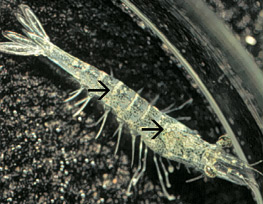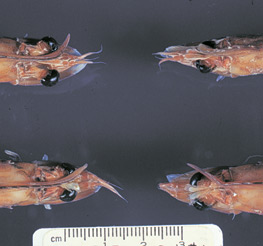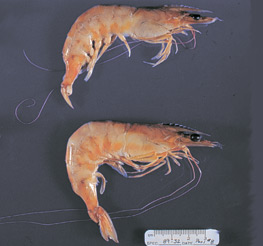Diseases of crustaceans
Viral diseases—Infectious hypodermal and haematopoietic necrosis
CLICK ON IMAGE TO ENLARGE

Source: DV Lightner
CLICK ON IMAGE TO ENLARGE

Source: DV Lightner
CLICK ON IMAGE TO ENLARGE

Source: DV Lightner
Signs of disease
Important: animals with disease may show one or more of the signs below, but disease may still be present in the absence of any signs.
Disease signs at the tank and pond level
- reduced food consumption
- sometimes prawns repeatedly float slowly to water surface, roll over and then sink to bottom
- increasing morbidity/mortality
Clinical signs of disease in an infected animal
- reduced and irregular growth in juveniles and subadults (runt-deformity syndrome)
- white to buff mottling of shell, especially at the junction of shell plates of the abdomen
- giant black tiger prawn (Penaeus monodon) may appear blue
- deformed rostrums grow to one side
Disease agent
Infectious hypodermal and haematopoietic necrosis (IHHN), or runt-deformity syndrome, is caused by a parvovirus.
Host range
Crustaceans known to be susceptible to IHHN:
blue shrimp* (Penaeus stylirostris)
giant black tiger prawn* (Penaeus monodon)
grooved tiger prawn* (Penaeus semisulcatus)
Kuruma prawn* (Penaeus japonicus)
Pacific white shrimp* (Penaeus vannamei)
southern white shrimp* (Penaeus schmitti)
western white shrimp* (Penaeus occidentalis)
yellow-leg shrimp* (Penaeus californiensis)
Chinese white shrimp (Penaeus chinensis)
Gulf banana prawn (Penaeus merguiensis)
Indian banana prawn (Penaeus indicus)
northern brown shrimp (Penaeus aztecus)
northern pink shrimp (Penaeus duorarum)
northern white shrimp (Penaeus setiferus)
* naturally susceptible (other species have been shown to be experimentally susceptible)
Presence in Asia–Pacific

IHHN virus has been officially reported from Australia, Burma (Myanmar), Indonesia, Iran, Malaysia, Thailand and Vietnam.
Epidemiology
- Gross signs of disease in an infected animal (ie stunted or deformed rostrum) appear at about 35 days of postlarval development (PL-35). Earlier larval stages do not present gross signs but may still be carriers.
- The typical gross signs referred to as runt-deformity syndrome may be observed in juveniles and subadults.
- Infected adults seldom show mortalities or signs of the disease.
- IHHN virus-resistant prawns and early life stages carry the virus with them, transferring it to more susceptible species and life stages.
- This is a chronic condition that suppresses the prawns' defence system, allowing infection by other, more serious disease agents.
- IHHN virus in infected shrimp tissues remains infectious after five years of storage at –20°C and after 10 years at –80°C.
- Transmission is horizontal via water and ingestion, and can also be vertical, from parent to progeny.
Differential diagnosis
The differential diagnostic table and the list of similar diseases appearing at the bottom of each disease page refer only to the diseases covered by this field guide. Gross signs observed might well be representative of a wider range of diseases not included here. Therefore, these diagnostic aids should not be read as a guide to a definitive diagnosis, but rather as a tool to help identify the listed diseases that most closely account for the gross signs.
Similar diseases
White spot disease, yellowhead disease
Sample collection
Because of uncertainty in differentiating diseases using only gross signs, and because some aquatic animal disease agents might pose a risk to humans, you should not try to collect samples unless you have been trained. Instead, you should phone your national hotline number and report your observations. If samples have to be collected, the agency taking the call will advise you on what you need to do. Local or district fisheries/veterinary authorities could advise you on sampling.
Emergency disease hotline
For your national emergency disease hotline number, see Whom to contact if you suspect a disease.
Further reading
http://www.oie.int/aac/eng/cards/en_diseasecard.htm
The currently accepted procedures for a conclusive diagnosis of IHHN are summarised at http://www.oie.int/eng/normes/fmanual/A_00053.htm
These hyperlinks were correct and functioning at the time of publication.

